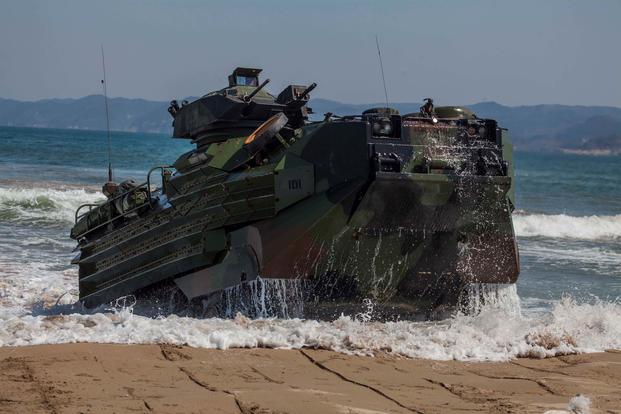Five Marines are in critical condition and 10 more are receiving medical care for burns after an amphibious assault vehicle erupted into fire during training at Camp Pendleton, California Wednesday morning.
Officials with 1st Marine Division said Wednesday evening that eight of the 15 Marines aboard the vehicle were medically evacuated to the Burn Center at University of California San Diego Health, with three Marines there in critical condition, and five Marines in serious condition.
Another four Marines were taken to University of California Irvine's Medical Center, where two remain in critical condition and the other two are receiving treatment, their condition unknown, officials said.
On Marine is in stable condition and being treated at Scripps Memorial Hospital La Jolla, and two more are being treated on base at Naval Hospital Camp Pendleton with minor injuries.
"The 1st Marine Division would like to thank the civilian and military emergency personnel who responded immediately to the situation and allowed the injured Marines to receive rapid care," 1st Lt. Paul Gainey, a spokesman for the division, said in a statement. "Our thoughts and prayers are with the Marines and their families affected by this incident."
The land-based training accident took place just after 9:30 a.m. local time, Gainey said earlier today.
The troops, all from units within 1st Marine Division, had been conducting scheduled battalion training at the time. Officials said the Marines injured in the fire were from 1st Battalion, 1st Marine Regiment and 3rd Assault Amphibian Battalion.
They were conducting a combat readiness evaluation when the vehicle caught fire.
Business Insider, which first reported the news, said the Marines involved in the training are attached to Charlie Company, 1st Battalion, 1st Marines.
The last Class-A mishap involving an amphibious assault vehicle was on Sept. 16, 2013, when Cpl. Nicholas Sell died after ordnance ignited his AAV during a training exercise.
After that tragedy, the Marine Corps stopped using its mine clearance system, the MK-154.
Just weeks ago, in August, the Corps rolled out a new version of the system, the MK-154 Mod 1, saying it had additional built-in safety and reliability features.
The cause of Wednesday's AAV fire is not yet clear. Officials are investigating the circumstances surrounding the incident, Gainey said.
-- Hope Hodge Seck can be reached at hope.seck@military.com. Follow her on Twitter at @HopeSeck.



























